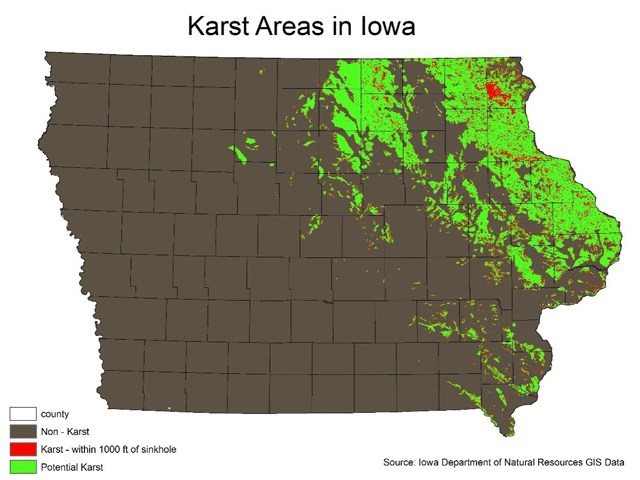Ag Policy Blog
A Small Contradiction of American Environmental Policies on Earth Day
It often seems that agriculture and environmentalism run in both parallel and opposite directions at the same time.
This is happening right now in northeast Iowa.
Last week, Iowa environmental groups petitioned EPA to step in and protect drinking water from agricultural runoff. The groups argue Iowa officials are not doing enough to protect groundwater from nitrogen pollution. The petition asks EPA to intervene, as the agency did in the karst region of southeast Minnesota last year.
"The well-documented nitrate contamination of drinking water in the karst region necessitates prompt and decisive EPA emergency action," the petition states.
The petition was filed on April 16 after the Iowa Environmental Protection Commission voted unanimously to largely maintain the current standards for animal feeding operations. Initially, the Iowa Department of Natural Resources last fall had spelled out additional requirements for livestock operations in the karst areas of northeast Iowa, the Cedar Rapids Gazette reported.
(See, "Environmental Groups Want EPA to Intervene in Northeast Iowa Drinking Water Nitrates Problem," https://www.dtnpf.com/…)
On the same day environmental groups called on EPA to help with water quality in northeast Iowa, a federal lawsuit was filed in an Iowa federal court as another effort to essentially end USDA's wetland regulatory "swampbuster" rule that goes back to the 1985 farm bill.
P[L1] D[0x0] M[300x250] OOP[F] ADUNIT[] T[]
Leading up to the 1985 farm bill -- and coming out of the 1980s farm crisis -- conservationists sought to protect wetlands and reduce crop production on environmentally sensitive grounds. Congress passed the swampbuster provision to protect wetlands and the sodbuster language to limit unbroken prairie acres from going into production.
The sodbuster case involves 71.85 acres in Delaware County, Iowa, also in the northeast part of the state. Delaware county happens to be in the middle of the same karst area of Iowa as well. The property has 10.4 acres considered erodible land and enrolled in the Conservation Reserve Program. There also are 9 acres considered a wetland that is part of a larger 21.6 acres of woodland. That leaves 39.8 acres to farm.
The plaintiff looking to bust the sodbuster rule is CTM LLC, whose managing member owns or manages roughly 1,075 acres in eastern Iowa.
After CTM bought the Delaware County ground and filed forms with USDA, the Natural Resources Conservation Service (NRCS) notified CTM that 9 acres had been certified as a wetland under a previous owner in 2010. CTM maintains the wetland does not actually contain any standing water or show signs of being wet. CTM signed on with Pacific Legal Foundation to challenge USDA's authority to designate the ground as a wetland and potentially take away CTM's government benefits on 1,075 acres if the nine acres is farmed.
Under the swampbuster rules, if a farmer develops wetland acres to farm then they lose access to USDA programs, not just for the property in question, but all of the farmer's land. That includes not just commodity programs, but also loans and crop-insurance premium subsidies.
The lawsuit argues that the government easement given over wetland properties essentially amounts to a physical taking of the ground without just compensation. The lawsuit also pointed to swampbuster rules regulating wetlands, "regardless of how isolated they are from navigable waterways," a reference to the Supreme Court ruling last year in the Sackett cases that upended federal oversight of most wetlands under the Clean Water Act.
The Iowa lawsuit also follows the pathway of another Pacific Legal Foundation case involving South Dakota farmer Arlen Foster, who has taken his swampbuster case over 0.8 acres to the U.S. Supreme Court, where the petition still awaits a decision from justices over whether they are going to hear arguments over it.
(See, "Foster Supreme Court Wetland Case Hinges on Previous Case Argued Before Court," https://www.dtnpf.com/…)
This scenario is almost a synopsis of U.S. environmental policy on the country's 54th Earth Day. We have demands for new regulatory actions almost daily, while long-standing policies are facing court challenges that could end their usefulness.
Chris Clayton can be reached at Chris.Clayton@dtn.com
Follow him on social platform X @ChrisClaytonDTN
(c) Copyright 2024 DTN, LLC. All rights reserved.






Comments
To comment, please Log In or Join our Community .